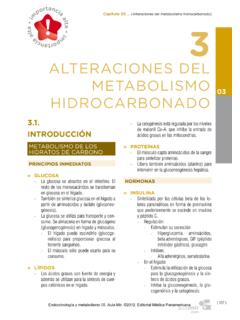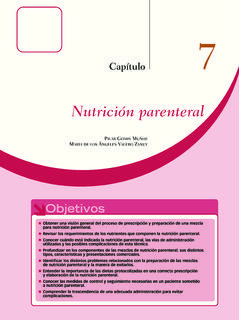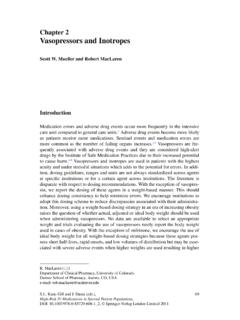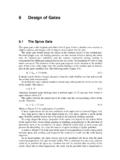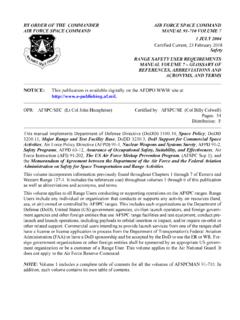Transcription of Probe Design, Production, and Applications - Axón
1 Probe design , production , Applications1313 From: Medical Biomethods HandbookEdited by: J. M. Walker and R. Rapley Humana Press, Inc., Totowa, NJ2 Probe design , production , and ApplicationsMarilena Aquino de Muro1. IntroductionA Probe is a nucleic acid molecule (single-stranded DNA or RNA) with a strong affinitywith a specific target (DNA or RNA sequence). Probe and target base sequences must becomplementary to each other, but depending on conditions, they do not necessarily have to beexactly complementary. The hybrid ( Probe target combination) can be revealed when appro-priate labeling and detection systems are used. Gene probes are used in various blotting and insitu techniques for the detection of nucleic acid sequences. In medicine, they can help in theidentification of microorganisms and the diagnosis of infectious, inherited, and other Probe DesignThe Probe design depends on whether a gene Probe or an oligonucleotide Probe is Gene ProbesGene probes are generally longer than 500 bases and comprise all or most of a target can be generated in two ways.
2 Cloned probes are normally used when a specific clone isavailable or when the DNA sequence is unknown and must be cloned first in order to be mappedand sequenced. It is usual to cut the gene with restriction enzymes and excise it from an agarosegel, although if the vector has no homology, this might not be chain reaction (PCR) is a powerful procedure for making gene probes because itis possible to amplify and label, at the same time, long stretches of DNA using chromosomal orplasmid DNA as template and labeled nucleotides included in the extension step (see Subhead-ings and ). Having the whole sequence of a gene, which can easily be obtained fromdatabases (GenBank, EMBL, DDBJ), primers can be designed to amplify the whole gene orgene fragments (see Chapter 28). A considerable amount of time can be saved when the gene ofinterest is PCR amplified, for there is no need for restriction enzyme digestion, electrophoresis,and elution of DNA fragments from vectors. However, if the PCR amplification gives nonspe-cific bands, it is recommended to gel purify the specific band that will be used as a probes generally provide greater specificity than oligonucleotides because of theirlonger sequence and because more detectable groups per Probe molecule can be incorporatedinto them than into oligonucleotide probes (1).
3 Oligonucleotide ProbesOligonucleotide probes are generally targeted to specific sequences within genes. The mostcommon oligonucleotide probes contain 18 30 bases, but current synthesizers allow efficientsynthesis of probes containing at least 100 bases. An oligonucleotide Probe can match perfectly14 Aquino de Muroits target sequence and is sufficiently long to allow the use of hybridization conditions that willprevent the hybridization to other closely related sequences, making it possible to identify anddetect DNA with slight differences in sequence within a highly conserved gene, for selection of oligonucleotide Probe sequences can be done manually from a known genesequence using the following guidelines (1): The Probe length should be between 18 and 50 bases. Longer probes will result in longerhybridization times and low synthesis yields, shorter probes will lack specificity. The base composition should be 40 60% G-C. Nonspecific hybridization may increase for G-C ratios outside of this range.
4 Be certain that no complementary regions within the Probe are present. These may result in theformation of hairpin structures that will inhibit hybridisation to target. Avoid sequences containing long stretches (more than four) of a single base. Once a sequence meeting the above criteria has been identified, computerized sequence analy-sis is highly recommended. The Probe sequence should be compared with the sequence regionor genome from which it was derived, as well as to the reverse complement of the region. Ifhomologies to nontarget regions greater than 70% or eight or more bases in a row are found,that Probe sequence should not be , to determine the optimal hybridization conditions, the synthesized Probe shouldbe hybridized to specific and nonspecific target nucleic acids over a range of same guidelines are applicable to design forward and reverse primers for amplifica-tion of a particular gene of interest to make a gene Probe . It is important to bear in mind that, inthis case, it is essential that the 3' end of both forward and reverse primers have no homologywith other stretches of the template DNA other than the region you want to amplify.
5 There arenumerous software packages available (LaserDNA , GeneJockey II , etc.) that can be usedto design a primer for a particular sequence or even just to check if the pair of primers designedmanually will perform as Labeling and Types of Radioactive LabelsNucleic acid probes can be labeled using radioactive isotopes ( , 32P, 35S, 125I, 3H). Detec-tion is by autoradiography or Geiger Muller counters. Radiolabeled probes used to be the mostcommon type but are less popular today because of safety considerations as well as cost anddisposal of radioactive waste products. However, radiolabeled probes are the most sensitive, asthey provide the highest degree of resolution currently available in hybridization assays (1,2).High sensitivity means that low concentrations of a Probe target hybrid can be detected; forexample, 32P-labeled probes can detect single-copy genes in only g of DNA and Kellerand Manak (1) list a few reasons: 32P has the highest specific activity. 32P emits -particles of high energy.
6 32P-Labeled nucleotides do not inhibit the activity of DNA-modifying enzymes, because thestructure is essentially identical to that of the nonradioactive 32P-labeled probes can detect minute quantities of immobilized target DNA (<1pg), their disadvantages is the inability to be used for high-resolution imaging and their rela-tively short half-life ( d); 32P-labeled probes should be used within a week after lower energy of 35S plus its longer half-life ( d) make this radioisotope more usefulthan 32P for the preparation of more stable, less specific probes . These 35S-labeled probes ,although less sensitive, provide higher resolution in autoradiography and are especially suit-able for in situ hybridization procedures. Another advantage of 35S over 32P is that the 35S- Probe design , production , Applications15labeled nucleotides present little external hazard to the user. The low-energy -particles barelypenetrate the upper dead layer of skin and are easily contained by laboratory tubes and , 3H-labeled probes have traditionally been used for in situ hybridization becausethe low-energy -particle emissions result in maximum resolution with low background.
7 It hasthe longest half-life ( yr).The use of 125I and 131I has declined since the 1970 s with the availability of 125I-labelednucleoside triphosphates of high specific activity. 125I has lower energies of emission and alonger half-life (60 d) than 131I, and are frequently used for in situ Nonradioactive LabelsCompared to radioactive labels, the use of nonradioactive labels have several advantages: Safety. Higher stability of Probe . Efficiency of the labeling reaction. Detection in situ. Less time taken to detect the over laboratory safety and the economic and environmental aspects of radioactivewaste disposal have been key factors in their development and use. Some examples are asfollows: Biotin: This label can be detected using avidin or streptavidin which have high affinities forbiotin. Because the reporter enzyme is not conjugated directly to the Probe but is linked to itthrough a bridge ( , streptavidin biotin), this type of nonradioactive detection is known asan indirect system.
8 Usually, biotinylated probes work very well, but because biotin (vitaminH) is a ubiquitous constituent of mammalian tissues and because biotinylated probes tend tostick to certain types of Nylon membrane, high levels of background can occur during hybrid-izations. These difficulties can be avoided by using nucleotide derivatives, includingdigoxigenen-11-UTP, -11-dUTP, and -11-ddUTP, and biotin-11-dUTP or hybridization, these are detected by an antibody or avidin, respectively, followed by acolor or chemiluminescent reaction catalysed by alkaline phosphatase or peroxidase linked tothe antibody or avidin (1,2). Enzymes. The enzyme is attached to the Probe and its presence usually detected by reactionwith a substrate that changes color. Used in this way, the enzyme is sometimes referred to as a reporter group, Examples of enzymes used include alkaline phosphatase and horseradishperoxidase (HRP). In the presence of peroxide and peroxidase, chloronaphtol, a chromogenicsubstrate for HRP, forms a purple insoluble product.
9 HRP also catalyzes the oxidation ofluminol, a chemiluminogenic substrate for HRP (2,3). Chemiluminescence. In this method, chemiluminescent chemicals attached to the Probe aredetected by their light emission using a luminometer. Chemiluminescent probes (including theabove enzyme labels) can be easily stripped from membranes, allowing the membranes to bereprobed many times without significant loss of resolution. Fluorescence chemicals attached to Probe fluoresce under ultraviolet (UV) light. This type oflabel is especially useful for the direct examination of microbiological or cytological speci-mens under the microscope a technique known as fluorescent in situ hybridization (FISH).Hugenholts et al. have some useful considerations on Probe design for FISH (4). Antibodies. An antigenic group is coupled to the Probe and its presence detected using specificantibodies. Also, monoclonal antibodies have been developed that will recognize DNA RNAhybrids. The antibodies themselves have to be labeled, using an enzyme, for example.
10 DIG system. It is the most comprehensive, convenient, and effective system for labeling anddetection of DNA, RNA, and oligonucleotides. Digoxigenin (DIG), like biotin, can be chemi-cally coupled to linkers, and nucleotides and DIG-substituted nucleotides can be incorporatedinto nucleic acid probes by any of the standard enzymatic methods. These probes generallyyield significantly lower backgrounds than those labeled with biotin. An anti-digoxigenin an-16 Aquino de MuroTable 1 Types of LabelRadioactive labels32P35S125I131I3 HNonradioactive labelsBiotinChemiluminescent enzyme labels (acridinium ester, alkalinephosphatase, -D-galactosidase, horseradish peroxidase[HRP], isoluminol, xanthine oxidase)Fluorescence chemicals (fluorochromes)AntibodiesDigoxigenin systemtibody alkaline phosphatase conjugate is allowed to bind to the hybridized DIG-labeled signal is then detected with colorimetric or chemiluminescent alkaline phosphatase sub-strates. If a colorimetric substrate is used, the signal develops directly on the membrane.


